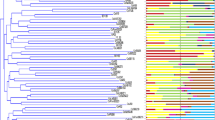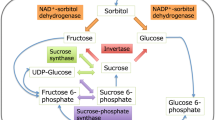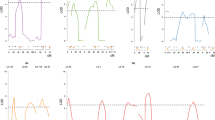Abstract
Sucrose content is one of the most important traits considered in sugarcane breeding. Since sugarcane cultivars possess >100 chromosomes (2n = 100–130) and are genetically complex polyploid and aneuploids, identification of quantitative trait loci (QTLs) associated with sucrose content is considered the best option to improve sucrose content through molecular breeding. A preliminary genetic linkage map of Louisiana sugarcane cultivar ‘LCP 85-384’ from a previous study was enriched using 65 additional polymorphism simple-sequence-repeats (SSR) primer-pairs to identify more co-segregated and homologous groups (CGs and HGs) and QTLs controlling sucrose content. Eighty-four SSR primer-pairs produced 456 markers, of which 441 were polymorphic. Both simplex (993) and duplex (225) amplified fragment length polymorphism (AFLP) and target region amplification polymorphism (TRAP) markers reported previously were also included to construct the LCP 85-384 map. These simplex and duplex markers were assigned to 108 CGs successfully using JoinMap®. This map had a cumulative genome length of 7406.3 cM that included 675 AFLP (69.8 %), 90 TRAP (9.3 %), and 202 SSR (20.9 %) markers. The 202 SSR markers were assigned to 65 CGs and 8 HGs. Based on this map, 24 putative QTLs affecting sucrose content were identified. Five QTLs were unlinked and the other 19 QTLs were located on nine CGs within four HGs. Of these QTLs, 11 had an effect in both plant-cane (20.33 %) and first-stubble (25.68 %) crops. A higher efficiency of QTLs’ identification with AFLP, TRAP and SSR markers in such a genetically complex crop, proposes its wider utility in molecular breeding in sugarcane.











Similar content being viewed by others
References
Aitken KS, Jackson PA, McIntyre CL (2005) A combination of AFLP and SSR markers provide extensive map coverage and identification of homo(eo)logous linkage groups in a sugarcane cultivar. Theor Appl Genet 110:789–801
Aitken KS, Jackson PA, McIntyre CL (2006) Quantitative trait loci identified for sugar related traits in a sugarcane (Saccharum spp.) cultivar × Saccharum officinarum population. Theor Appl Genet 112:1306–1317
Aitken KS, Jackson PA, McIntyre CL (2007) Construction of genetic linkage map for Saccharum officinarum incorporating both simplex and duplex markers to increase genome coverage. Genome 50:742–756
Alwala S, Suman A, Arro JA, Veremis JC, Kimbeng CA (2006) Target region amplification polymorphism (TRAP) for assessing genetic diversity in sugarcane germplasm collections. Crop Sci 46:448–455
Alwala S, Kimbeng CA, Veremis JC, Gravois KA (2008) Linkage mapping and genome analysis in Saccharum interspecific cross using AFLP, SRAP and TRAP markers. Euphytica 164:37–51
Alwala S, Kimbeng CA, Veremis JC, Gravois KA (2009) Identification of molecular markers associated with sugar-related traits in a Saccharum interspecific cross. Euphytica 167:127–142
Asnaghi C, Paulet F, Kaye C, Grivet L, Deu M, Glaszmann JC, D’Hont A (2000) Application of synteny across Poaceae to determine the map location of a sugarcane rust resistance gene. Theor Appl Genet 101:962–969
Asnaghi C, Roques D, Ruffel S, Kaye C, Hoarau JY, Te‘lismart H, Girard JC, Raboin LM, Risterucci AM, Grivet L, D’Hont A (2004) Targeted mapping of a sugarcane rust resistance gene (Bru1) using bulked segregant analysis and AFLP markers. Theor Appl Genet 108:759–764
Bischoff KP, Gravois KA (2004) The development of new sugarcane varieties at the LSU Ag Center. J Am Soc Sugar Cane Technol 24:142–164
Cheng XM, Xu JS, Xia S, Gu JX, Yang Y, Fu J, Qian XJ, Zhang SC, Wu JS, Liu K (2009) Development and genetic mapping of microsatellite markers from genome survey sequences in Brassica napus. Theor Appl Genet 118:1121–1131
Cordeiro GM, Taylor GO, Henry RJ (2000) Characterisation of microsatellite markers from sugarcane (Saccharum spp.), a highly polyploid species. Plant Sci 155:161–168
Cunff LL, Garsmeur O, Raboin LM, Pauquet J, Telismart H, Selvi A, Grivet L, Philippe R, Begum D, Deu M, Costet L, Wing R, Glaszmann JC, D’Hont A (2008) Diploid/polyploidy syntenic shuttle mapping and haplotype-specific chromosome walking toward a rust resistance gene (Bru1) in highly polyploidy sugarcane (2n 12 × 115). Genetics 180:649–660
D’Hont A, Ison D, Alix K, Roux C, Glaszmann G (1998) Determination of basic chromosome numbers in the genus Saccharum by physical mapping of ribosomal RNA genes. Genome 41:221–225
Da Silva JAG (2001) Preliminary analysis of microsatellite markers derived from sugarcane expressed sequence tags (ESTs). Genet Mol Biol 24:155–159
Daugrois JH, Grivet L, Grivet L, Roques D, Hoarau JY, Lombard H, Glaszmann JC, D’Hont A (1996) Putative major gene for rust resistance linked with a RFLP marker in sugarcane cultivar ‘R570’. Theor Appl Genet 92:1059–1064
Dufour P, Grivet L, D’Hont A, Deu M, Trouche G, Glaszmann JC, Hamon P (1996) Comparative genetic mapping between duplicated segments on maize chromosomes 3 and 8 and homoeologous regions in sorghum and sugarcane. Theor Appl Genet 92:1024–1030
Falconer DS, Mackay TFC (1996) Introduction to quantitative genetics. Longman Group, Harlow
Garcia AAF, Kido EA, Meza AN, Souza HMB, Pinto LR, Pastina MM, Leite CS, Da Silva JAG, Ulian EC, Figueira A, Souza AP (2006) Development of an integrated genetic map of a sugarcane (Saccharum spp.) commercial cross, based on a maximum likelihood approach for estimation of linkage and linkage phases. Theor Appl Genet 112:298–314
Gravois KA, Bischoff KP (2008) New sugarcane varieties to the rescue. La Agric 51:14–16
Grivet L, D’Hont A, Roques D, Feldmann P, Lanaud C, Glaszmann JC (1996) RFLP mapping in a highly polyploid and aneuploid interspecific hybrid. Genetics 142:987–1000
Guimaráes CT, Sills GR, Sobral BWS (1997) Comparative mapping of Andropogoneae: Saccharum (sugarcane) and its relation to sorghum and maize. Proc Natl Acad Sci USA 94:14261–14266
Hoarau JY, Offmann B, D’Hont A, Risterucci AM, Roques D, Glaszmann JC, Grivet L (2001) Genetic dissection of a modern sugarcane cultivar (Saccharum spp.). I. Genome mapping with AFLP markers. Theor Appl Genet 103:84–97
Hoarau JY, Grivet L, Offmann B, Raboin LM, Diorflar JP, Payet J, Hellmann M, D’Hont A, Glaszmann JC (2002) Genetic dissection of a modern sugarcane cultivar (Saccharum spp.). II. Detection of QTLs for yield components. Theor Appl Genet 105:1027–1037
Jackson PA (2005) Breeding for improved sugar content in sugarcane. Field Crops Res 92:277–290
Kosambi DD (1944) The estimation of map distances from recombination values. Ann Eugen 12:172–175
Lakshmanan P, Geijskes RJ, Aitken KS, Grof CLP, Bonnet GD, Smith GR (2005) Sugarcane biotechnology: the challenges and opportunities. In Vitro Cell Dev Biol Plant 41:345–363
Legendre BL, Henderson MT (1972) The history and development of sugar yield calculations. J Am Soc Sugar Cane Technol 2:10–18
Liu P, Que Y, Pan Y-B (2011) Highly polymorphic microsatellite DNA markers for sugarcane germplasm evaluation and variety identity testing. Sugar Tech 13:129–136
Lowe A, Moule C, Trick M, Edwards K (2004) Efficient large-scale development of microsatellites for marker and mapping applications in Brassica crop species. Theor Appl Genet 108:1103–1112
Ming R, Liu SC, Lin YR, Da Silva JAG, Wilson W, Braga D, van Devnze A, Wenslaff F, Wu KK, Moore PH, Burnquist W, Sorrells ME, Irvine JE, Paterson AH (1998) Detailed alignment of Saccharum and Sorghum chromosomes: comparative organization of closely related diploid and polyploid genomes. Genetics 150:1663–1682
Ming R, Liu SC, Moore PH, Irvine JE, Paterson AH (2001) QTL analysis in a complex autopolyploid: genetic control of sugar content in sugarcane. Genome Res 11:2075–2084
Ming R, Liu S-C, Bowers JE, Moore PH, Irvine JE, Paterson AH (2002a) Construction of Saccharum consensus genetic map from two interspecific crosses. Crop Sci 42:570–583
Ming R, Wang YW, Draye X, Moore PH, Irvine JE, Paterson AH (2002b) Molecular dissection of complex traits in autopolyploids: mapping QTLs affecting sugar yield and related traits in sugarcane. Theor Appl Genet 105:332–345
Oliveira KM, Pinto LR, Marconi TG, Margarido GRA, Pastina MM, Teixeira LHM, Figueira AV, Ulian EC, Garcia AAF, Souza AP (2007) Functional integrated genetic linkage map based on EST markers for a sugarcane (Saccharum spp.) commercial cross. Mol Breed 20:189–208
Oliveira KM, Pinto LR, Marconi TG, Mollinari M, Ulian EC, Chabregas SM, Falco MC, Burnquist WA, Garcia AF, Souza AP (2009) Characterization of new polymorphic functional markers for sugarcane. Genome 52:191–209
Pan Y-B (2006) Highly polymorphic microsatellite DNA markers for sugarcane germplasm evaluation and variety identity testing. Sugar Tech 8:246–256
Pan Y-B, Burner DM, Legendre BL (2000) An assessment of the phylogenetic relationship among sugarcane and related taxa based on the nucleotide sequence of 5S rRNA intergenic spacers. Genetica 108:285–295
Pan Y-B, Cordeiro GM, Richard EP Jr, Henry RJ (2003) Molecular genotyping of sugarcane clones with microsatellite DNA markers. Maydica 48:319–329
Pan Y-B, Scheffler BS, Richard EP Jr (2007) High throughput genotyping of commercial sugarcane clones with microsatellite (SSR) DNA markers. Sugar Tech 9:176–181
Parida SK, Kalia SK, Kaul S, Dalal V, Hemprapha G, Selvi A, Pandit A, Singh A, Gaikwad K, Sharma TR, Srivastava PS, Singh NK, Mohapatra T (2009) Informative genomic microsatellite markers for efficient genotyping application in sugarcane. Theor Appl Genet 118:327–338
Parida SK, Pandit A, Gaikwad K, Sharma TR, Srivastava PS, Singh NK, Mohapatra T (2010) Functionally relevant microsatellites in sugarcane unigenes. BMC Plant Biol 10:251
Pinto LR, Garcia AAF, Pastina MM, Teixeira LHM, Bressiani JA, Ulian EC, Bidoia MAP, Souza AP (2010) Analysis of genomic and functional RFLP derived markers associated with sucrose content, fiber and yield QTLs in a sugarcane (Saccharum spp.) commercial cross. Euphytica 172:313–327
Piperidis N, Jackson PA, D’Hont A, Besse P, Hoarau JY, Courtois B, Aitken KS, McIntyre CL (2008) Comparative genetics in sugarcane enables structured map enhancement and validation of marker-trait associations. Mol Breed 21:233–247
Piquemal J, Cinquin E, Couton F (2005) Construction of an oilseed rape (Brassica napus L.) genetic map with SSR markers. Theor Appl Genet 111:1514–1523
Podlich DW, Winkler CR, Cooper M (2004) Mapping as you go: an effective approach for marker-assisted selection of complex traits. Crop Sci 44:1560–1571
Ripol MI, Churchill GA, da Silva JAG, Sorrells M (1999) Statistical aspects of genetic mapping in autopolyploids. Gene 235:31–41
SAS Institute Inc (2008) SAS/STAT_ 9.2 user’s guide. SAS Institute Inc, Cary
Schon C, Utz HF, Groh S, Truberg B, Openshaw S, Melchinger AE (2004) Quantitative trait locus mapping based on re-sampling in a vast maize testcross experiment and its relevance to quantitative genetics for complex traits. Genetics 167:485–498
Singh RK, Srivastava S, Singh SP, Sharma ML, Mohopatra T, Singh NK, Singh SB (2008) Identification of new microsatellite DNA markers for sugar and related traits in sugarcane. Sugar Tech 10:327–333
Singh RK, Singh SP, Tiwari DK, Srivastava S, Singh SB, Sharma ML, Singh R, Mohopatra T, Singh NK (2013) Genetic mapping and QTL analysis for sugar yield-related traits in sugarcane. Euphytica 191:333–353
Sokal RR, Rohlf FJ (1995) Biometry. W.H. Freeman and Co, New York
Suman A, Pan Y-B, Thongthawee S, Burner DM, Kimbeng C (2011) Genetic analysis of the sugarcane (Saccharum spp.) cultivar ‘LCP 85-384’. I. Linkage mapping using AFLP, SSR, and TRAP markers. Theor Appl Genet 123:77–93
Van Ooijen JW (2006) JoinMap®4, Software for the calculation of genetic linkage maps in experimental populations. Kyazma B. V., Wageningen
Yang J, Hu CC, Hu H, Yu RD, Xia Z, Ye XZ, Zhu J (2008) QTLNetwork: mapping and visualizing genetic architecture of complex traits in experimental populations. Bioinformatics 24:721–723
Acknowledgments
AFLP and TRAP marker data were kindly provided by Collins Kimbeng and Suman Andru. This research was partially funded by grower/processor check-off funds administrated by the American Sugar Cane League of the USA., Inc., Thibodaux, Louisiana, USA. Greenhouse and field technical supports were provided by Jennifer Chiasson, Elta Duet, Brian Duet, Cory Landry, Lionel Lomax, Jeri Maggio, Norris Matherne, Eric Petrie, Clinton Randall, Randy Richard, David Verdun, and Kathy Warnke. SSR-PCR and ABI3730XL-based fragment analysis were conducted by Sheron Simpson at the USDA-ARS, MSA Genomics Laboratory directed by Brian Scheffler. Amaresh Chandra gratefully acknowledges Department of Biotechnology, Government of India for DBT-CREST Fellowship Award.
Authors’ contributions
YBP conceived, designed and directed the study. PL, YQ and YBP collected SSR marker data. PL analyzed the molecular and phenotypic data, constructed the genetic and QTL map, and drafted the manuscript. AC performed phenotypic data analysis, interpreted the data, and participated in manuscript preparation. PHC, MPG, CDD, TLT, WHW, and YBP conducted field trials and collected phenotypic data. PL, AC, YQ, MPG, and YBP participated in manuscript preparation. All authors have read and approved the final manuscript.
Author information
Authors and Affiliations
Corresponding author
Ethics declarations
Competing interests
The authors declare that they have no competing interests.
Disclaimer
Product names and trademarks are mentioned to report factually on available data; however, the USDA neither guarantees nor warrants the standard of the product, and the use of the name by USDA does not imply the approval of the product to the exclusion of others that may also be suitable. The experiments reported comply with the current laws of USA.
Additional information
Pingwu Liu and Amaresh Chandra have contributed equally to this work.
Rights and permissions
About this article
Cite this article
Liu, P., Chandra, A., Que, Y. et al. Identification of quantitative trait loci controlling sucrose content based on an enriched genetic linkage map of sugarcane (Saccharum spp. hybrids) cultivar ‘LCP 85-384’. Euphytica 207, 527–549 (2016). https://doi.org/10.1007/s10681-015-1538-5
Received:
Accepted:
Published:
Issue Date:
DOI: https://doi.org/10.1007/s10681-015-1538-5




